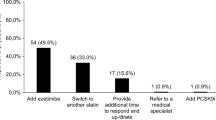Abstract
OBJECTIVE:
To assess the effect of a program that encourages teamwork between physicians and pharmacists on attempts to lower total cholesterol levels and to meet recommended goals proposed by the National Cholesterol Education Program (NCEP).
DESIGN
A single-blind, randomized, controlled trial lasting 6 months.
SETTING:
An ambulatory primary care center.
PATIENTS:
A sample of 94 patients with total cholesterol levels of 240 mg/dL (6.2 mmol/L) or higher. INTERVENTION: Equal numbers of patients were randomly assigned to a control arm in which standard medical care was received and an intervention arm which implemented close interaction between physicians and pharmacists.
MEASUREMENTS AND MAIN RESULTS:
Absolute change in total cholesterol levels from baseline values and the percentage of patients who achieved an NCEP goal after 6 months of intervention were determined. The rate of success in achieving NCEP goals in the intervention arm was double the rate in the control arm (43% vs 21%, p < .05). Total cholesterol levels in the intervention arm declined 44 +/- 47 mg/dL (1.1 +/- 1.2 mmol/L) versus 13 +/- 51 mg/dL (0.3 +/- 1.3 mmol/L) in the control arm (p < .01). The effect of intervention on reducing total cholesterol levels was similar for men and women and did not appear to be altered by age. The effect of intervention was greatest in patients with coronary heart disease (p < .01) followed by those without disease but with two or more coronary heart disease risk factors (p < .05). An effect of intervention was absent in patients without coronary heart disease and with fewer than two risk factors.
CONCLUSIONS:
Attempts to lower total cholesterol levels and achieve NCEP goals are likely to be more successful when combined with programs that include teamwork between physicians and pharmacists. Some programs, however, may be more successful for high-risk patients, for whom it is often easier to provide more aggressive therapies. Although altering adverse lipid profiles in lower-risk patients may be difficult, achieving optimal cholesterol levels could have an important impact on preventing movement to higher risk strata.
Similar content being viewed by others
Author information
Authors and Affiliations
Rights and permissions
About this article
Cite this article
Bogden, P., Koontz, L., Williamson, P. et al. The Physician and Pharmacist Team: An Effective Approach to Cholesterol Reduction. J GEN INTERN MED 12, 158–164 (1997). https://doi.org/10.1007/s11606-006-5023-7
Published:
Issue Date:
DOI: https://doi.org/10.1007/s11606-006-5023-7




